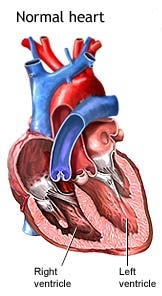Functions of the Circulatory System
The circulatory system has a very important job to do in your body. It transports nutrients and oxygen to the body's cells, and carries the waste product of cellular respiration (carbon dioxide) to the lungs to be exhaled. The circulatory system is made of arteries, veins, capillaries, and the heart. The arteries carry the the blood away from the heart, to the lungs and the rest of the body. The veins carry the blood back to the heart, from the lungs and from systemic circulation.
The human heart has two sides, and each side has 2 chambers. The right side takes the oxygen poor blood from systemic circulation, and sends it to the lungs. The left side takes the oxygen rich blood from the lungs, and pumps it to the rest of the body. Each side has an atria and a ventricle.
The human heart has two sides, and each side has 2 chambers. The right side takes the oxygen poor blood from systemic circulation, and sends it to the lungs. The left side takes the oxygen rich blood from the lungs, and pumps it to the rest of the body. Each side has an atria and a ventricle.
What does the Circulatory System do for the body?
Good question. The circulatory system transports nutrients and oxygen to the cells in your body so they can stay healthy and perform cellular respiration. Without the circulatory system, your body could not function. The oxygen transported by the circulatory system is a needed "fuel" for all cells, tissues, and organs in the body. The product of cellular respiration, carbon dioxide, is picked up by the red blood cell and sent to the lungs. If the cells are sickle shaped, then the oxygen your cells need won't stick to the cell's hemoglobin and carbon dioxide will stay in your blood stream. If this happens, the body is seriously hindered and WILL eventually die!

